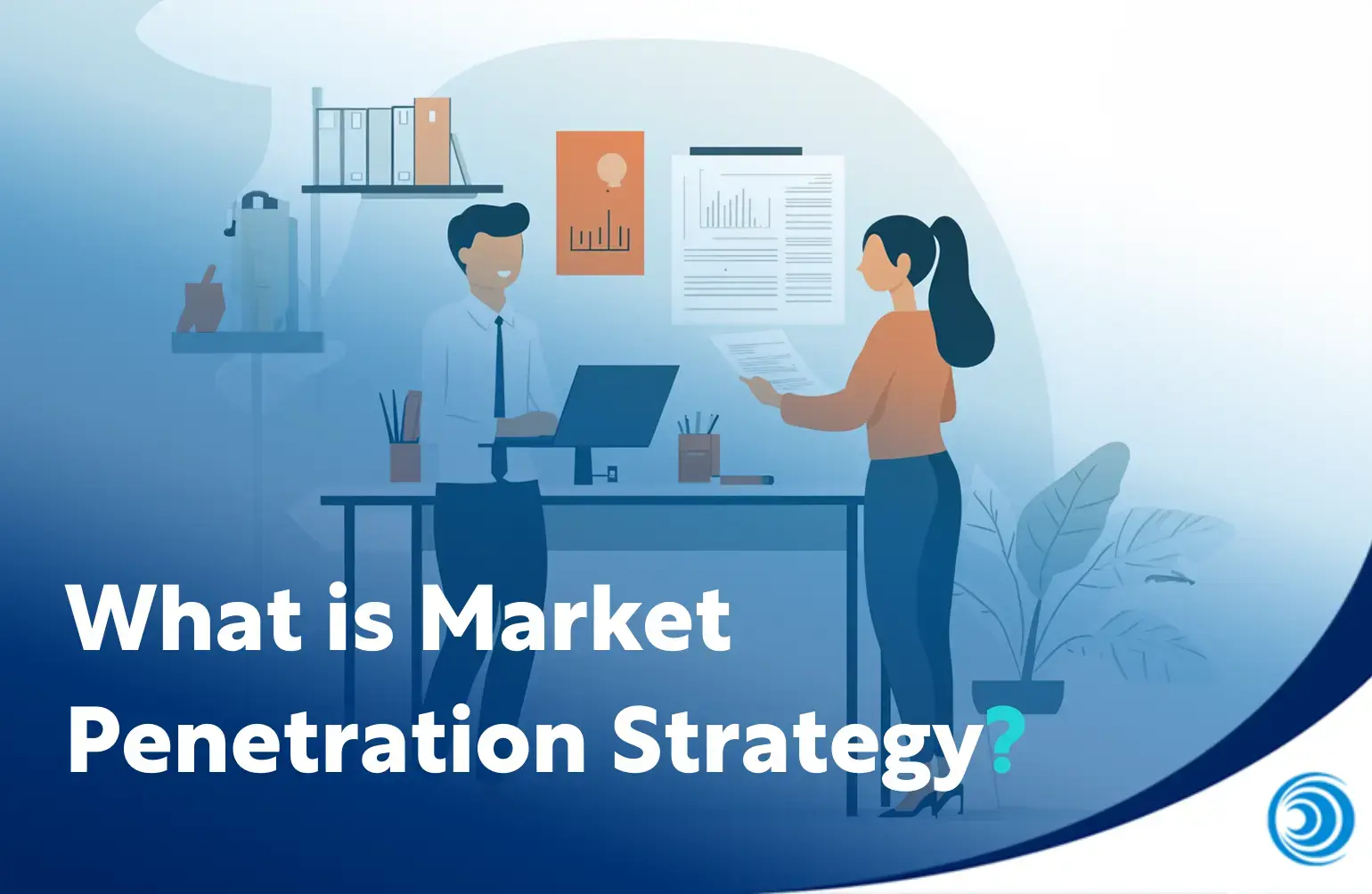
What is Market Penetration Strategy? A Guide to Effective Techniques
Without a marketing penetration strategy, a business cannot expand its reach and enhance its profitability.
Companies must find innovative ways to deepen their market presence, using various strategies, from attracting new customers to retaining existing ones to forming strategic partnerships.
Whether you're a fintech startup or an established industry player, understanding market dynamics and implementing effective market penetration tactics can lead to sustainable growth and increased market share.
What is Market Penetration?
Market penetration is the quantity of products or services sold to existing customers compared to the approximate total market for those products or services.
In the fintech sector, for instance, a digital payment platform might analyse the number of existing users actively using its services compared to the total number of users in a market.
It is a measurement tool used to determine the total estimated market size or to help develop market penetration strategies to increase a product or service's market share.
There are many ways to increase market penetration - such as attracting more customers, retaining existing customers, or acquiring competitors - but the end goal remains the same: gaining a larger market presence.
The Asnoff Matrix
Market penetration is often associated with the Asnoff Matrix, a strategic planning tool that narrows focus and helps businesses decide on growth strategies.
The matrix presents four key growth strategies, categorised according to whether they involve a new or existing market or product.
-
Market Penetration is a strategy used to capture more of an existing market with an existing product or offering. It is considered a low-risk strategy. For example, a fintech advisory firm might aim to deepen its relationship with current clients by introducing new advisory services tailored to their investment goals.
-
Product Development: To gain market share with a new product or service offering.
-
Market Development: A strategy to capture a new target audience with an existing product or service.
-
Diversification: An attempt to penetrate new markets with a new product or offering. This market penetration strategy is considered to be the most high-risk of them all. For instance, a fintech company specialising in personal loans may decide to branch out into business loans, targeting an entirely different market segment.
How to Calculate Market Penetration
Market penetration is measured by market penetration rates, which calculate the proportion of the total addressable market that a brand, product, or service captures.
Market Penetration Rate = (Number of Customers / Total Addressable Market) x 100
For example, if a business has a market share of 200,000 customers in a market of 2,000,000 potential customers, the market penetration rate is 10%.
It's important for businesses to regularly calculate and update their market penetration rate to gauge a deep understanding of penetration success. A good market penetration rate ensures high market penetration after a product launch, allowing for monitoring when numbers may dwindle.
Market Penetration Strategies
There are six main market penetration strategies from product pricing to resourcing a strong sales team.
Product Pricing
It's unlikely that a company will increase sales and market share by marketing its products or services at a higher price point.
One example is a fintech app offering low-cost remittances. This app might attract more users by emphasising its competitive pricing compared to traditional banks.
To offer competitive pricing, businesses must have a sufficient understanding of their input costs and profit margins. They must also understand consumer preferences and whether lowering prices will be attractive to target customers.
Target New Geographies
With increased online sales, businesses may have more comprehensive access to new markets and geographies than they realise.
A company may deploy the market penetration strategy of moving, developing, and expanding into new regions.
Without leaving their origin country, organisations can fund operations in another region by leveraging increased market penetration at an existing site.
Strategic Partnerships
Another way companies can penetrate new markets is through strategic partnerships with other like-minded businesses.
For example, a payment processor could partner with an eCommerce platform to streamline payment operations for small businesses.
By partnering with another business, organisations can gain access to customer bases that they wouldn't otherwise have access to.
Innovate Existing Products
Instead of creating an entirely new product, a company can update an already existing product.
With each iteration, the product can be improved further and offer potential customers new and exciting benefits.
The existing customer base may also be inclined to upgrade after a positive experience.
Create Promotional Opportunities
Companies that do not see value in permanently lowering prices can increase their market penetration by offering temporary promotional opportunities. This strategy can lure customers with attractive low prices.
Despite leading to immediate success, it is likely to attract the incorrect audience, especially if a business aims to be a high-quality company.
Invest in Sales Representatives
Even if a company successfully introduces a product to the market, its product launch may only succeed if it has the appropriate staff.
A company must be able to bring its product to market, communicate its value, and increase the current sale volume. This may require a company to increase the number of sales reps or invest in stronger talent.
Advantages of Market Penetration
Let's take a look at the key benefits of implementing this strategy.
Lower Risk
Sales reps actively selling existing products or services to existing markets is far less risky than penetrating or developing new products.
Fintech companies often deeply understand customer needs and preferences, making it easier to sell to existing clients.
Cost Efficiency
Building on an established product and market presence requires a much smaller investment than other growth strategies.
A fintech firm can leverage its existing technology and customer relationships to expand its offerings.
Greater Customer Loyalty
Improving the relationship with an existing customer base can help to build brand loyalty. Customer satisfaction is more likely to lead to repeat purchases and product or service recommendations, increasing the total sale volume.
Increased Market Share
A successful market penetration strategy allows businesses to claim a bigger market share of their existing market.
This deeper expansion into the current market can increase sales and profitability.
Competitive Advantage
Increased market share strengthens a business' position as a market leader, giving them a competitive advantage.
Disadvantages of Market Penetration
As well as considering the pros, it's also important to examine the cons from the effect on your brand image to additional business pressures.
Faltering Brand Image
If a company reduces the cost of a product, it risks diminishing the image of the product or the brand itself in the minds of the target audience, creating the wrong perception.
Several customers may feel the company has no choice but to lower costs due to a lack of consumer demand.
A fintech service might struggle to maintain its premium image if it frequently offers deep discounts.
Attracting the Wrong Audience
New target market members may be outside the ideal customer base throughout business growth.
An inherent risk of a wrong product fit could hinder the company's image due to incorrect audience segmentation.
Creates Pressure
Market penetration strategies can create unwanted pressure across all departments, from manufacturing and marketing to production and sales.
In fintech, the need for rapid user acquisition may strain customer support teams, leading to service issues.
How to Build an Effective Market Penetration Strategy
Identify Target Market
Businesses can use automation tools and market intelligence to identify their desired target audience effectively.
A fintech company can analyse transaction data to refine its customer profiles and better meet customers' needs. This oversight allows companies to remain competitive while streamlining workflow efficiency.
The ability of a business to identify its target audience and track its needs is a crucial component of increasing market penetration success.
Develop a Comprehensive Marketing Strategy
Once businesses gain an in-depth understanding of the ideal customer, they can develop an effective marketing strategy that integrates various marketing campaigns, such as advertising, social media, and content marketing.
Fintech firms can leverage content marketing to educate users on financial literacy, enhancing engagement.
Businesses must stay aware of the latest industry trends and continuously adapt their marketing campaigns to stay competitive and gain high market penetration.
Identify the Best Distribution Channels
Identifying the most effective channels for reaching potential and existing customers is essential.
Connecting with the right target audience is the key to commercial success, but where should a fintech company focus its efforts?
-
Social Media: Platforms, such as LinkedIn, can effectively target business professionals in the financial services sector.
-
Email Marketing: Emails are a reliable way to reach potential customers through personalised messaging and incentives.
-
Event Marketing: Attending industry events and networking with market leaders can lead to valuable business connections.
By utilising the best channels, businesses can find the best market penetration strategies to engage with potential customers and focus on market development for pre-existing products or services.
Have a Strong Website & Content
To stand out from the competition, businesses need more than an aesthetically appealing website; they also need content that resonates with the desired customer.
Understanding the current target market allows businesses to tailor their websites to meet customers' needs and preferences, ensuring that the content speaks to the audience in the intended way.
To effectively engage visitors, a fintech company's website should offer valuable resources, such as budgeting tools or calculators.
Continually tracking the effectiveness of content is essential in ensuring that it's converting the target audience down the sales funnel into paying customers.
Leverage Existing Customer Relationships
Maintaining strong relationships with existing customers is integral to business growth and success.
One way to achieve this is to offer loyalty programmes and discounts. This not only benefits loyal customers but can also attract new ones looking for a competitive deal.
By showing customers that their business is valued and their loyalty should be rewarded, businesses can increase customer retention and build a positive reputation as a market leader.
Track Progress & Strategies
As part of any marketing strategy, businesses should continuously track and monitor the success of their endeavours and make adjustments accordingly.
Conclusion
Mastering market penetration can significantly elevate a company's growth trajectory, especially in the dynamic fintech sector.
Businesses can enhance their market share by strategically engaging existing customers, exploring new opportunities, and minimising risks. The key is understanding customer needs, leveraging innovative strategies, and maintaining solid relationships.
Partnering with experts can be crucial for companies eager to refine their approach and capitalise on new growth avenues.
Blue Train Marketing specialises in developing tailored strategies that resonate with your target audience, driving meaningful engagement and results. Elevate your market penetration strategy today.


